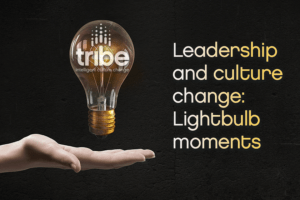Part of the work Tribe Culture Change do, is working with senior leaders to change their own behaviours. Often, only once leaders change, can an organisation progress on its culture change journey. Mark Ormond, Tribe Managing Director, shares all about psychology and working with senior leaders…
What do you enjoy about working in culture change?

Mark Ormond, Managing Director, Tribe
Mark Ormond (MO): “The bit I like the most is how we challenge people’s perceptions and shift them.
“People often get stuck in the ‘here and now’ but we get them to reflect on what the bigger picture could look like. People, particularly leaders, become caught in the day-to-day challenges of running companies and part of our role is to help them reflect on the cultural reality of what’s actually going on in their operation.
“The sessions we run with senior leaders are normally challenging but, personally, I enjoy adding a personal and strategic perspective into the mix.”
How does working in culture change provide a challenge?
(MO): “The biggest challenge is telling people things they don’t want to hear!
“I think, particularly over the last few years, people have felt overwhelmed by the challenges they’re facing. Once we’ve identified the issues people are dealing with in their organisations by carrying out a culture assessment, they naturally want solutions.
“There’s the linear approach – people think that if you do ‘x’ and ‘y’ they’ll get ‘z’ – but to get to ‘z’ leaders often need to reflect on their own change journey.
“Most leaders see the importance of health, safety and wellbeing, and they see the people in their businesses as being vital for success. They’re often trying to do their best, balancing health safety and wellbeing alongside other business challenges. As a result, they can feel affronted when they hear the reality of what’s going on in their organisations.
“But the decisions they’re making are sometimes leading to scary outcomes for their people and the business, and that is incredibly tough and overwhelming for leaders to hear. It’s our role to help them understand this reality in a way that’s sensitive but still inspires them to change.
“Health, safety and wellbeing is such a personal topic. People don’t want to hear that they’re the ones causing the issue. They’re not bad people. They’re just trying to do the right thing but they don’t always make the connection that their decisions have such an impact on people’s lives.”
How can you use a culture assessment to engage senior leaders?
(MO): “Most recently, the team at Tribe have been delivering a lot of culture assessment feedback sessions to senior leadership teams.
“This is where we’ve carried out a culture assessment through a mixture of surveys and focus groups to find out where a company is culturally. We share the results with the organisations’ leaders to see how we can go about changing the culture to make it a safer and happier place to work with fewer incidents.”
What do you cover in senior leadership workshops?

(MO): “Recently, in one of these senior leadership team sessions we had an interesting debate about the language used around a lost time incident (LTI).
“The company had a significant LTI and the CEO had experienced a fatal incident in the past. As a result of the passion they had about health and safety, the CEO sent an email to all staff in response to the LTI and the wording they used might make people think twice about sharing near misses in the future. They came down pretty hard on everyone.
“Instead, the language of an email such as this can encourage people to open up and share. Their email could have been along the lines of “I’m really glad people are telling me what’s going on…please keep telling me… let’s help to move the conversation forward… etc”.
“There are these lightbulb moments as part of cultural development. People are always full of good intentions but the reality can sometimes be different.
“Another recent moment was in a workshop where we were discussing an incentive programme which encouraged people to do better quality work. However, what the workforce heard was a need to get the job done faster and disregard safety.
“What leaders hadn’t anticipated was the workforce’s deep-rooted mistrust of anything new. The senior leaders were trying to do the right thing but they didn’t understand their organisational culture and the confirmation bias. Anything new the company put in place would be seen through this filter and they’d come up against a struggle.
“Thankfully the culture assessment unearthed this issue. We can now work with them to turn the company culture around.”
What underpins these discussions?
(MO): “It all comes down to psychology. I find it fascinating. People do have the capacity to change their behaviours but sometimes it’s just a case of opening their eyes and allowing them to see things differently.”
Thank you Mark. If you’d like to find out more about Tribe’s work, please get in touch or sign up to our monthly emails full of insight and culture change information, Tribe Vibe. You can also attend its free virtual Masterclasses where Tribe consultants will share insight and show examples of how to create better, safer and more proactive work cultures.
The Safety Conversation Podcast: Listen now!
The Safety Conversation with SHP (previously the Safety and Health Podcast) aims to bring you the latest news, insights and legislation updates in the form of interviews, discussions and panel debates from leading figures within the profession.
Find us on Apple Podcasts, Spotify and Google Podcasts, subscribe and join the conversation today!



